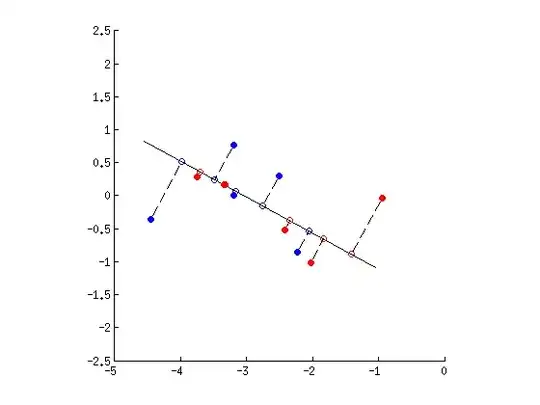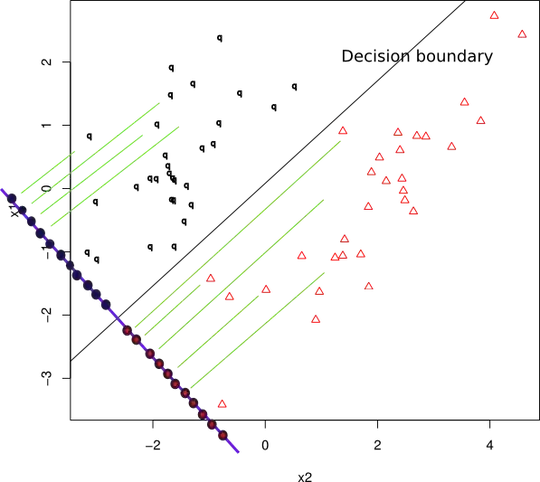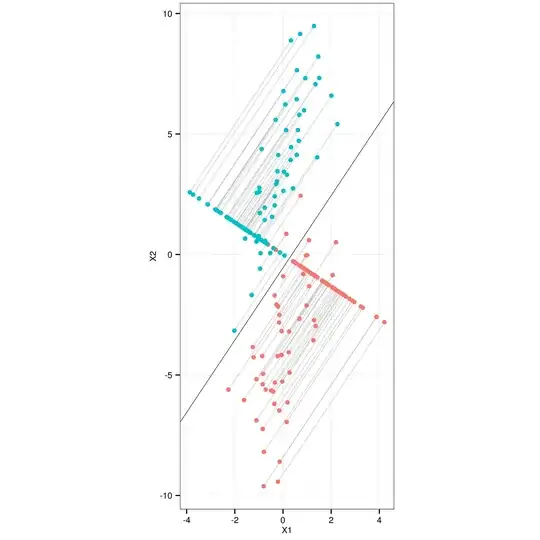The discriminant axis (the onto which the points are projected on your Figure 1) is given by the first eigenvector of $\mathbf{W}^{-1}\mathbf{B}$. In case of only two classes this eigenvector is proportional to $\mathbf{W}^{-1}(\mathbf{m}_1-\mathbf{m}_2)$, where $\mathbf{m}_i$ are class centroids. Normalize this vector (or the obtained eigenvector) to get the unit axis vector $\mathbf{v}$. This is enough to draw the axis.
To project the (centred) points onto this axis, you simply compute $\mathbf{X}\mathbf{v}\mathbf{v}^\top$. Here $\mathbf{v}\mathbf{v}^\top$ is a linear projector onto $\mathbf{v}$.
Here is the data sample from your dropbox and the LDA projection:

Here is MATLAB code to produce this figure (as requested):
% # data taken from your example
X = [-0.9437 -0.0433; -2.4165 -0.5211; -2.0249 -1.0120; ...
-3.7482 0.2826; -3.3314 0.1653; -3.1927 0.0043; -2.2233 -0.8607; ...
-3.1965 0.7736; -2.5039 0.2960; -4.4509 -0.3555];
G = [1 1 1 1 1 2 2 2 2 2];
% # overall mean
mu = mean(X);
% # loop over groups
for g=1:max(G)
mus(g,:) = mean(X(G==g,:)); % # class means
Ng(g) = length(find(G==g)); % # number of points per group
end
Sw = zeros(size(X,2)); % # within-class scatter matrix
Sb = zeros(size(X,2)); % # between-class scatter matrix
for g=1:max(G)
Xg = bsxfun(@minus, X(G==g,:), mus(g,:)); % # centred group data
Sw = Sw + transpose(Xg)*Xg;
Sb = Sb + Ng(g)*(transpose(mus(g,:) - mu)*(mus(g,:) - mu));
end
St = transpose(bsxfun(@minus,X,mu)) * bsxfun(@minus,X,mu); % # total scatter matrix
assert(sum(sum((St-Sw-Sb).^2)) < 1e-10, 'Error: Sw + Sb ~= St')
% # LDA
[U,S] = eig(Sw\Sb);
% # projecting data points onto the first discriminant axis
Xcentred = bsxfun(@minus, X, mu);
Xprojected = Xcentred * U(:,1)*transpose(U(:,1));
Xprojected = bsxfun(@plus, Xprojected, mu);
% # preparing the figure
colors = [1 0 0; 0 0 1];
figure
hold on
axis([-5 0 -2.5 2.5])
axis square
% # plot discriminant axis
plot(mu(1) + U(1,1)*[-2 2], mu(2) + U(2,1)*[-2 2], 'k')
% # plot projection lines for each data point
for i=1:size(X,1)
plot([X(i,1) Xprojected(i,1)], [X(i,2) Xprojected(i,2)], 'k--')
end
% # plot projected points
scatter(Xprojected(:,1), Xprojected(:,2), [], colors(G, :))
% # plot original points
scatter(X(:,1), X(:,2), [], colors(G, :), 'filled')


